The Chicken and Broccoli Diet has gained attention as a straightforward approach to weight management, focusing primarily on these two foods due to their nutritional properties.
Chicken meat has lean protein, which may help with muscle building and satiety. Broccoli has a lot of fiber and vitamins, and it is low in calories.
This diet appeals to individuals seeking a high-protein, low-fat regimen that purportedly supports weight loss and helps maintain a calorie deficit.
While the simplicity of the diet is alluring, its restrictive nature means it typically provides around 1100 to 1200 calories daily. This amount is below the caloric needs for most adults.
Subsequently, the diet’s efficacy for weight loss stems largely from its creation of a considerable calorie deficit.
Dieters are typically encouraged to consume these foods with minor variations and are often limited to water and unsweetened tea for hydration.
Key Takeaways
- The diet is built on high-protein, low-fat principles.
- It provides fewer calories than most adults require.
- It’s a highly restrictive dietary approach.
Understanding the Chicken and Broccoli Diet
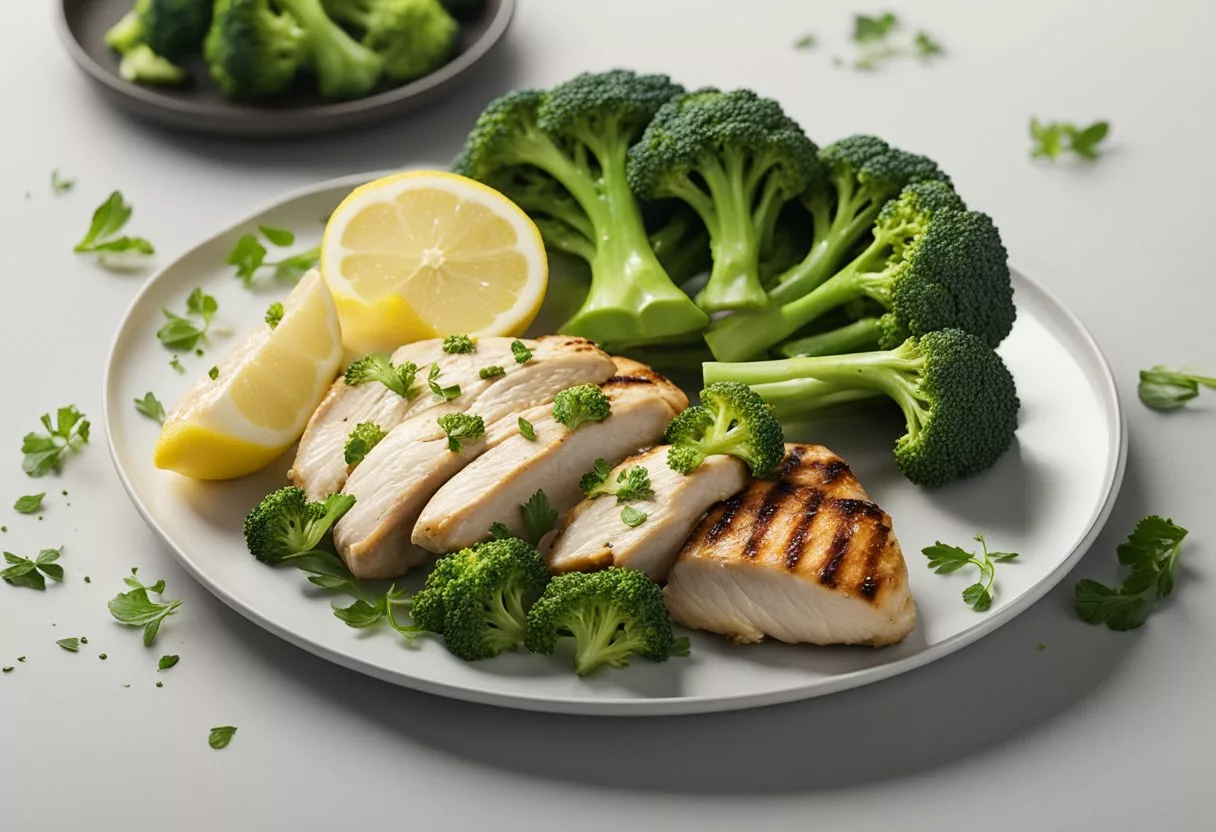
The Chicken and Broccoli Diet is often portrayed as a method geared towards weight loss through a specific diet plan involving chicken and broccoli as the main food sources.
Nutritional Profile
Chicken: A staple protein, chicken is low in fat and high in protein, essential for muscle building and maintenance. It stands out for its versatility and is often recommended for diets focused on lean protein intake.
Broccoli: Rich in vitamins C, K, and A, as well as dietary fiber, broccoli supports a healthy digestive system and provides crucial nutrients with very low caloric content.
Diet Structure
A typical chicken and broccoli diet includes:
- Daily Meals: Predominantly consisting of chicken and broccoli, sometimes accompanied by minimal additions such as brown rice for carbohydrates.
- Calorie Intake: The diet is characterized by a low-calorie intake, usually ranging from 1,100 to 1,200 calories per day to promote weight loss.
Chicken and broccoli serve as the diet’s foundation due to their combined nutritional benefits. Chicken offers a rich source of protein, and broccoli provides essential vitamins and fiber while maintaining a low calorie count.
The diet structure emphasizes minimalistic eating and is structured for those seeking weight loss through a healthy, but restrictive dietary regimen.
Benefits of Chicken and Broccoli
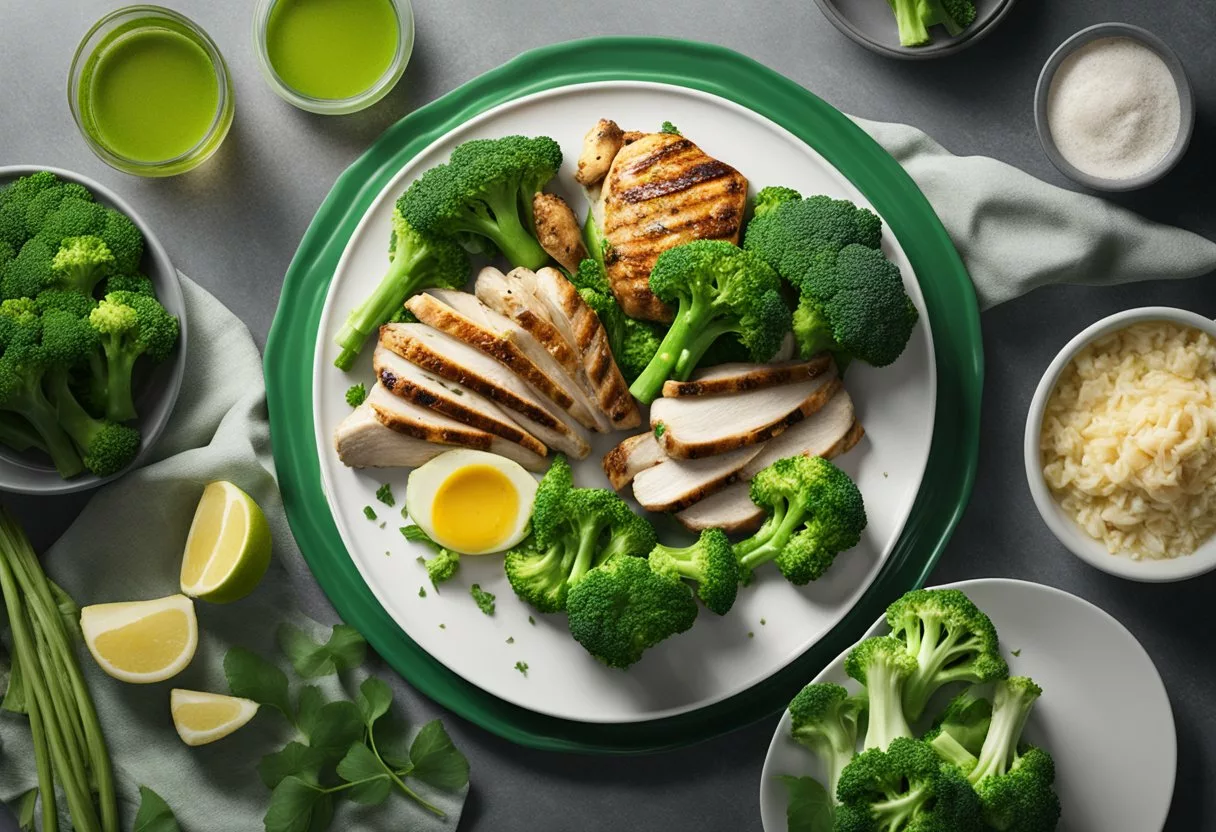
This section outlines the specific benefits of incorporating chicken and broccoli into one’s diet, focusing on weight management, muscle retention, metabolic function, and nutrient provision.
Weight Loss Advantages
Chicken and broccoli together create a powerful combination for those seeking to lose weight. The high protein content of chicken helps maintain satiety, reducing overall calorie intake. Meanwhile, broccoli provides fiber that aids in digestion and prolongs feelings of fullness.
Studies presented on Nutrition Lunatic highlight that a protein-rich diet is conducive to weight loss.
Muscle Mass Retention
Lean protein sources like chicken are essential for building and repairing muscle tissue, particularly important for those involved in regular physical activity. The protein helps one retain muscle mass while dieting, as noted in Marathon Handbook.
Metabolic Enhancements
The combination of chicken and broccoli can have positive effects on metabolic rate. The lean protein found in chicken can increase the thermic effect of food, meaning the body uses more energy to digest it, which may enhance metabolism.
Vitamins and Minerals Richness
Broccoli is a powerhouse of vitamins and minerals, including vitamin C, vitamin K, folate, and potassium. These nutrients are crucial for maintaining health and supporting bodily functions. Meanwhile, chicken is not only a source of lean protein but also provides important minerals.
Low in Calories and Fats
A diet emphasizing chicken and broccoli is low in calories and fats, which is beneficial for weight management and overall health. Broccoli is notably low in calories and virtually fat-free, while chicken, especially the breast, is a form of low-fat protein.
As shown on Fitness Volt, a strict chicken and broccoli diet severely restricts caloric intake.
Diet Implementation
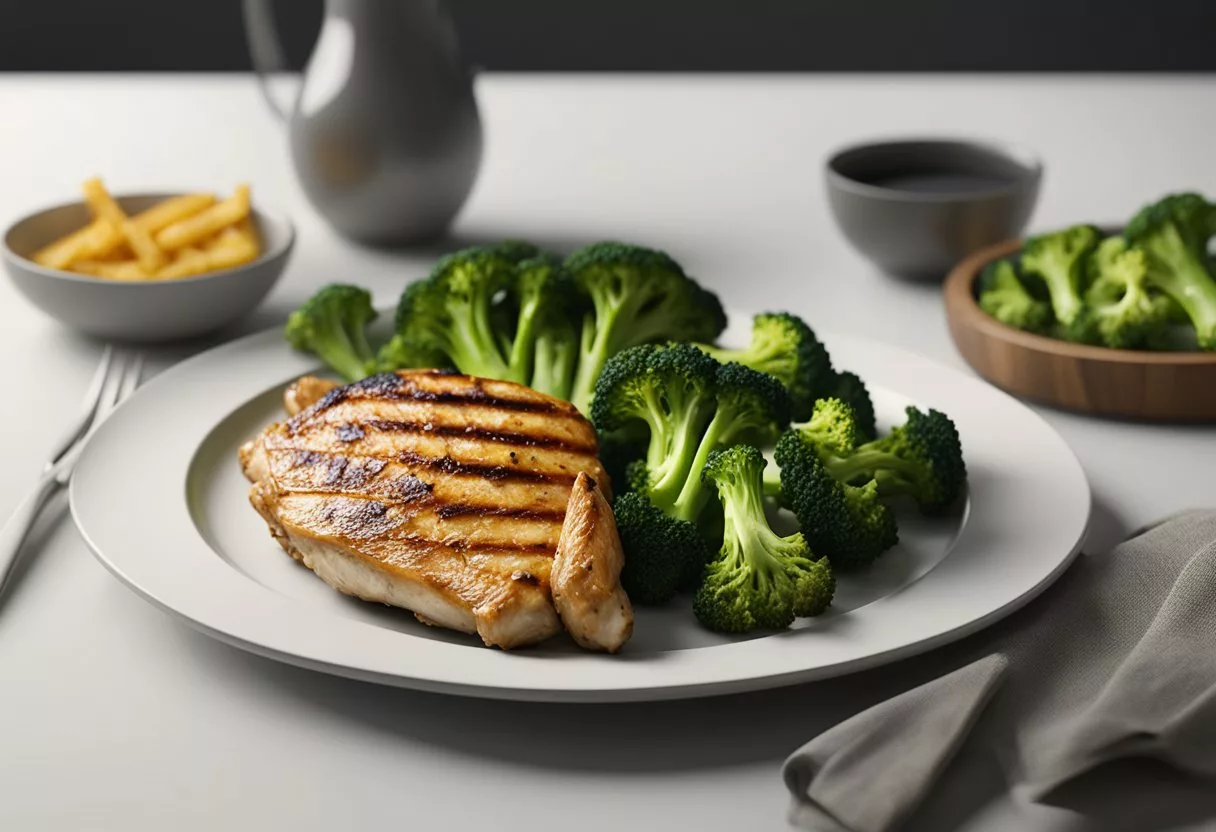
Implementing the chicken and broccoli diet efficiently requires a clear meal planning strategy, strict portion control, and a focus on hydration to ensure nutritional adequacy and the promotion of weight loss while minimizing water weight.
Meal Planning and Prep
Meal prep is crucial for the chicken and broccoli diet, as it helps manage calorie intake more effectively.
Individuals should plan meals that primarily include chicken and broccoli, varying recipes to prevent boredom. For instance, steamed broccoli with seasoned grilled chicken can be a basic yet satisfying meal.
It’s essential to calculate the caloric intake for each meal, keeping in mind that standard versions of the diet recommend around 1,100 to 1,200 calories daily.
Portion Control
Portion control is a significant aspect of this diet.
One way to implement this is by using measuring cups or a food scale to ensure portions align with the prescribed calorie count.
The chicken and broccoli diet restricts individuals to smaller portions, contributing to a caloric deficit, which is necessary for weight loss.
Dividing the daily calorie allowance into multiple small meals can help manage hunger and maintain energy levels throughout the day.
Hydration
Proper hydration is essential when following the chicken and broccoli diet as it helps to manage water weight and supports the body’s physiological functions.
Drink plenty of water throughout the day. Unsweetened beverages like black coffee and herbal tea can be included, but they should not replace water intake.
Staying hydrated also helps control hunger, as thirst can sometimes be mistaken for hunger.
Recipes and Cooking Methods
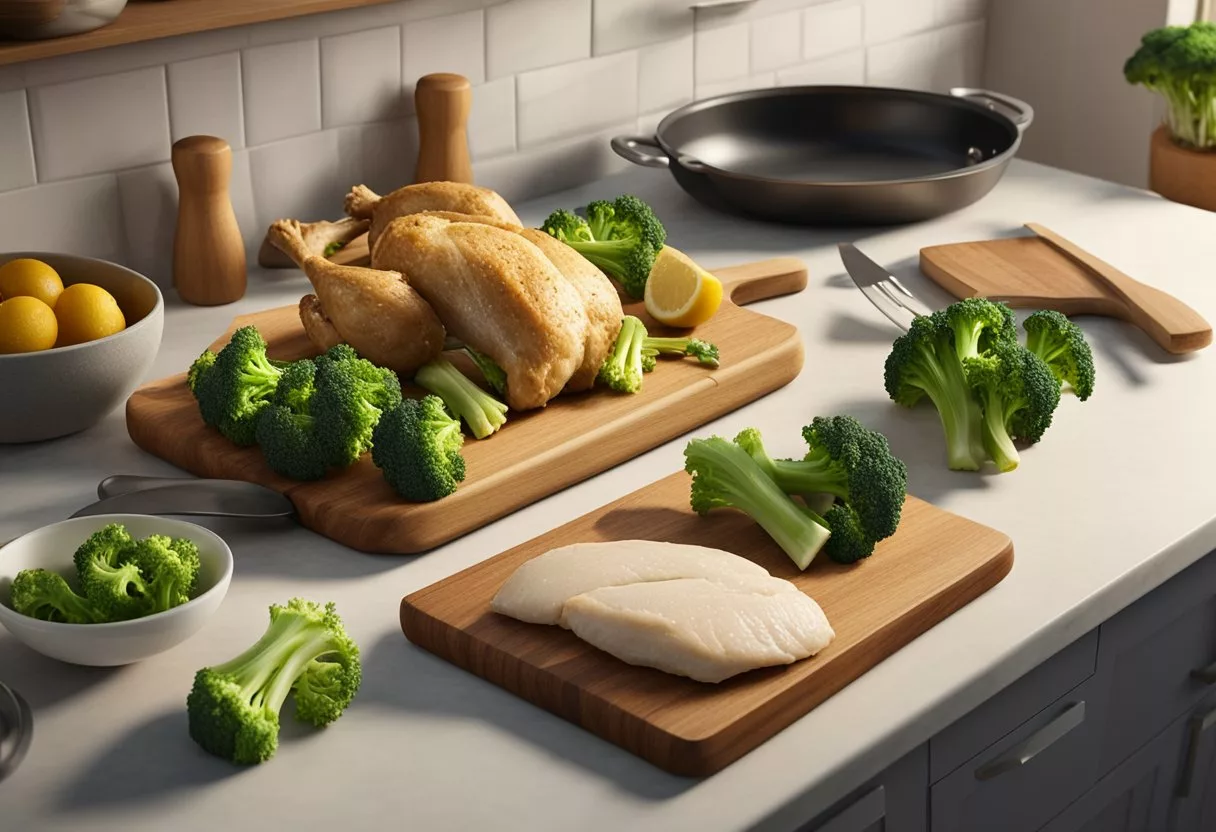
This section provides concrete methods for preparing healthy chicken and broccoli dishes, focusing on their nutritional benefits and flavor profiles. Each recipe offers a different technique to enjoy this nutritious combination.
Chicken and Broccoli Stir-Fry
For a quick and flavorful meal, the Chicken and Broccoli Stir-Fry is an ideal choice.
It typically involves sautéing broccoli and garlic in olive oil, then adding seasoned boneless, skinless chicken breasts to the pan.
This dish is often flavored with soy sauce, sesame oil, and a touch of honey, balancing the dish’s nutrition with delectable taste.
A typical stir-fry contains a moderate amount of calories, making it a suitable addition to a weight-conscious diet.
Ingredients:
- Broccoli
- Garlic
- Olive oil
- Boneless, skinless chicken breasts
- Sesame oil
- Honey
Calories: Moderate
Grilled Chicken and Steamed Broccoli
A Grilled Chicken and Steamed Broccoli meal is simple, yet satisfying.
Steaming broccoli preserves its nutrients and offers a vibrant green appearance while grilled chicken breast provides a lean protein source.
Marinating the chicken in lemon, garlic, and olive oil prior to grilling infuses it with a zesty flavor that complements the mild-tasting broccoli.
Preparation:
- Marinate chicken in lemon-garlic mixture.
- Grill until properly cooked.
- Steam broccoli until tender.
Calories: Low
Chicken and Broccoli Soup
For a comforting and healthy dish, try making a Chicken and Broccoli Soup.
This soup is a hearty option that combines chopped broccoli with tender pieces of chicken in a savory broth.
It’s a great way to enjoy a fulfilling meal with fewer calories compared to cream-based soups while still maintaining a high amount of protein.
Notable Ingredients:
- Chicken
- Broccoli
- Broth
Calories: Low to moderate
Enhancing Your Diet
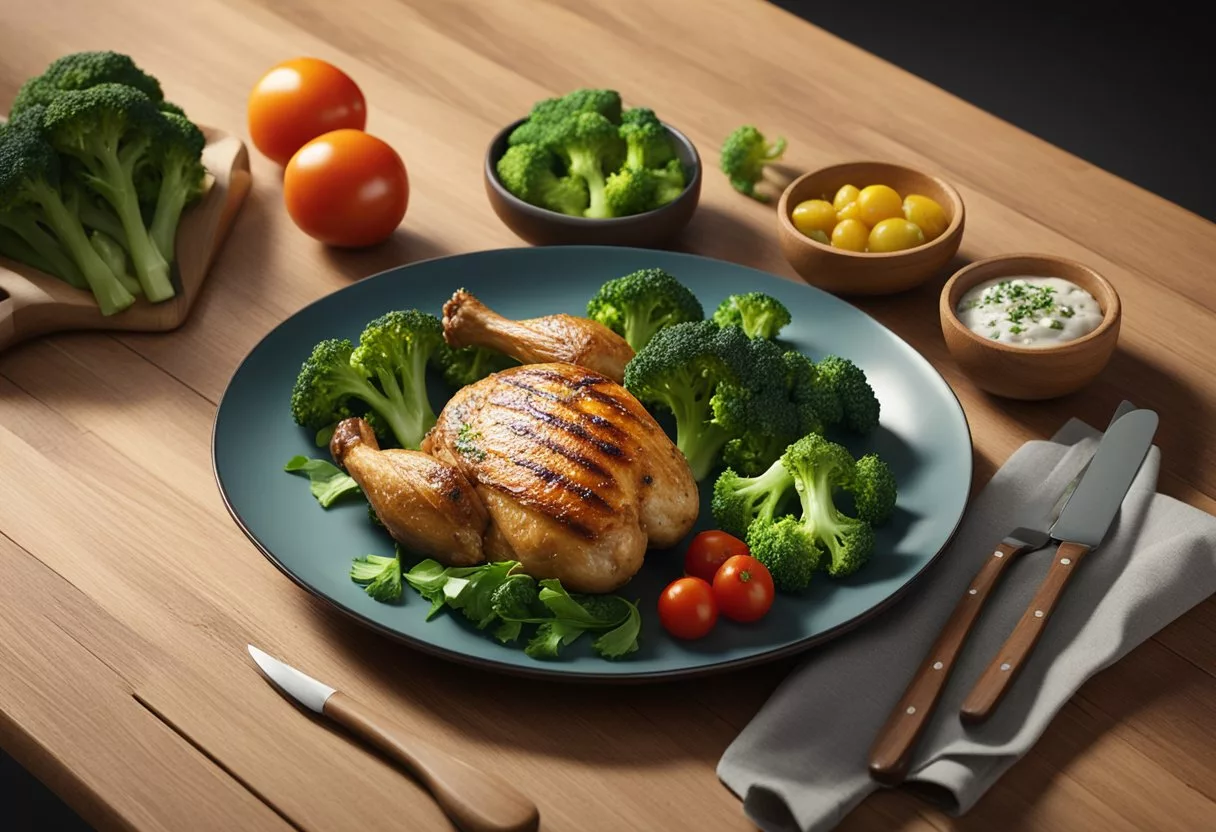
The following section provides practical strategies for diversifying and optimizing macronutrient intake within the chicken and broccoli diet framework. These enhancements aim to sustain dietary satisfaction and nutritional balance.
Incorporating Variety
To avoid monotony and ensure comprehensive nutrition, introducing a variety of vegetables and complex carbohydrates is advisable.
An individual could consider alternating broccoli with other nutrient-dense vegetables such as spinach, kale, or bell peppers. These vegetables add not only different flavors and textures but also a broad spectrum of vitamins and antioxidants.
Complex Carbohydrates:
- Brown Rice: A whole-grain alternative offering fiber and essential nutrients.
- Quinoa: A gluten-free option, high in protein and amino acids.
By incorporating these alternatives, one’s diet remains low in simple sugars while providing sustained energy through complex carbohydrates.
Balancing Macronutrients
Adequate macronutrient balance is key to maintaining health and promoting weight loss. Alongside lean meat like chicken breast, incorporating sources of healthy fats and proteins can enrich the diet. Examples include:
Fats:
- Avocado
- Nuts and Seeds
Proteins:
- Boiled Eggs: Offering essential amino acids and vitamins.
For those managing carbohydrate intake, integrating occasional servings of brown rice may support energy levels without breaching low-carb dietary goals. Balancing these macronutrients can aid in creating a nutritionally complete diet while still adhering to a weight loss plan.
Potential Risks and Considerations
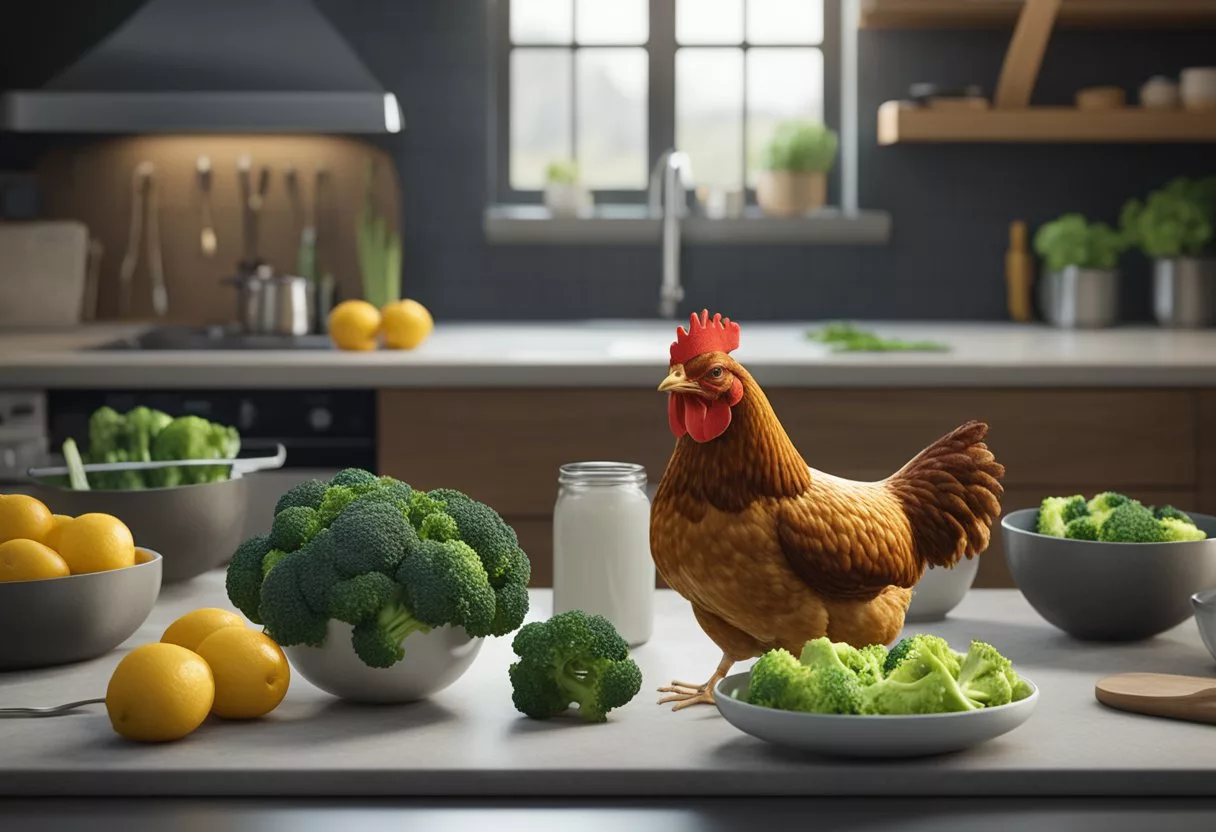
While the chicken and broccoli diet might promise quick weight loss results, there are several potential risks and considerations that one should be aware of. These include nutritional imbalances, psychological impacts, sustainability concerns, and the importance of consulting healthcare professionals.
Nutrition Imbalance
The chicken and broccoli diet is high in protein but significantly low in fat, and can lack other essential nutrients. Individuals adhering to this restrictive diet may face vitamin and mineral deficiencies, which can have detrimental effects on health such as weakened bones or compromised immune function. Nutritionists caution against diets that limit the variety of consumed foods.
Psychological Impacts
Restrictive diets may lead to disordered eating patterns. The monotony of eating only chicken and broccoli can result in low mood and increased cravings, which might lead to binging. Such psychological impacts should not be overlooked, as they can undermine long-term dietary success and mental well-being.
Sustainability Concerns
In terms of sustainability, the chicken and broccoli diet may not be practical or enjoyable in the long term. Individuals often find that following such a restrictive plan is challenging, which can lead to a low rate of adherence. Healthy eating patterns should encompass a variety of foods to ensure they are sustainable over a lifetime.
Consulting Professionals
Before starting any diet, it is advisable to consult with a healthcare professional, particularly a dietitian or nutritionist. They can evaluate individual health needs and risk factors, ensuring that any weight loss plan will provide adequate nutrition and support sustainable eating habits without leading to low energy levels or negative impacts on mood.
Supplementary Foods and Alternatives
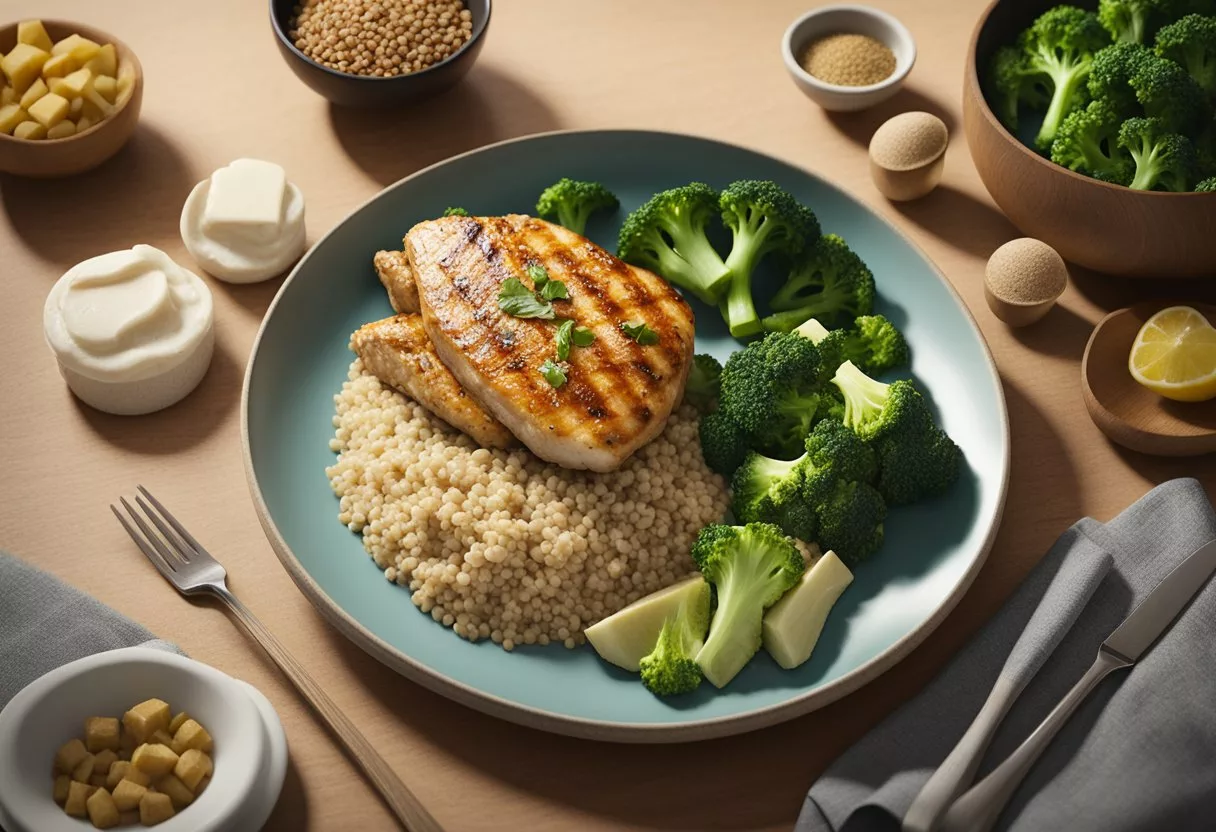
In the pursuit of a balanced diet, it is vital to include a variety of foods that offer other essential nutrients beyond what chicken and broccoli provide. Here are recommended additions to ensure dietary variety and nutritional completeness.
Vegetable Options
Vegetables are a cornerstone of a nutritious diet. Beyond broccoli, one can incorporate a range of other green vegetables such as spinach, kale, and Swiss chard, all excellent sources of vitamins and minerals. Also, non-green vegetables like tomatoes and onions can add flavor, antioxidants, and additional nutrients.
- Spinach: Rich in iron and calcium
- Kale: High in vitamins A, C, and K
- Tomato: Source of vitamin C and lycopene
- Onion: Offers taste and prebiotic fibers
Protein Alternates
Diversifying the sources of protein helps in providing a variety of essential amino acids and mitigating dietary boredom. Other lean proteins like turkey, fish, and tofu can replace chicken on occasion for this purpose.
- Turkey: Low-fat and high in protein
- Fish: Offers omega-3 fatty acids
- Tofu: A solid plant-based protein alternative
Smart Carbohydrate Choices
Complex carbohydrates are slower to digest, providing sustained energy. Whole wheat bread can be a smart choice to add fiber and nutrients. Integrating complex carbohydrates like quinoa, sweet potatoes, and brown rice helps in maintaining a balanced diet.
- Whole wheat bread: Good source of fiber
- Quinoa: Contains complete protein
- Sweet potatoes: Packed with vitamin A
Healthy Fats Intake
While a diet high in lean protein and vegetables is low in fat, one shouldn’t eliminate fat entirely. Fats are essential for nutrient absorption and brain health.
Olive oil, especially extra virgin olive oil, adds healthy monounsaturated fats and can be used in cooking or dressings.
- Olive oil: Healthy for heart and enhances flavor
- Extra virgin olive oil: Ideal for dressings and dips
Lifestyle Factors Influencing Diet Success
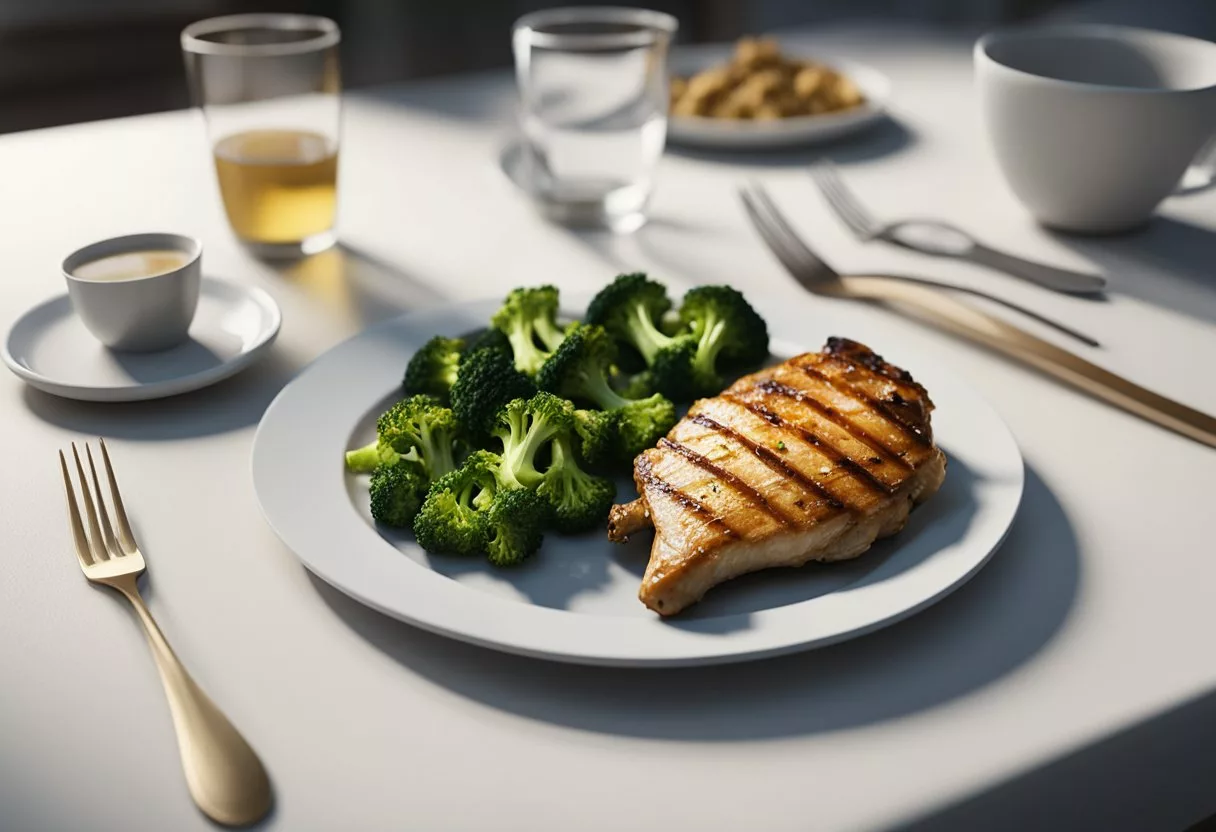
Successful adherence to a diet like the chicken and broccoli diet goes beyond the food on the plate. Incorporating consistent exercise, managing sleep and stress, and making informed hydration choices can influence metabolism, muscle mass, and the ability to lose weight.
Exercise and Physical Activity
Regular physical activity complements dietary efforts by enhancing metabolism and increasing muscle mass, both of which are crucial for burning more calories at rest.
It is important for individuals to engage in both aerobic exercises, such as running or cycling, which can aid in burning water weight, and resistance training, which helps in building muscle mass.
Sleep and Stress Management
Adequate sleep and effective stress management are pivotal for weight loss success. Lack of sleep can lead to hormonal imbalances that affect appetite and metabolism.
Managing stress through techniques such as yoga, deep breathing, or meditation can reduce the body’s production of cortisol, a hormone that can lead to water weight gain and hinder weight loss efforts.
Hydration and Fluid Choices
Hydration plays a role in detoxification and can have an anti-inflammatory effect on the body. Drinking sufficient water is essential for flushing out toxins and may help with reducing water weight.
The choice of fluids also matters; for instance, opting for unsweetened black tea can provide hydration without added calories, and the caffeine content can offer a slight metabolic boost.
Dining Out and Social Settings
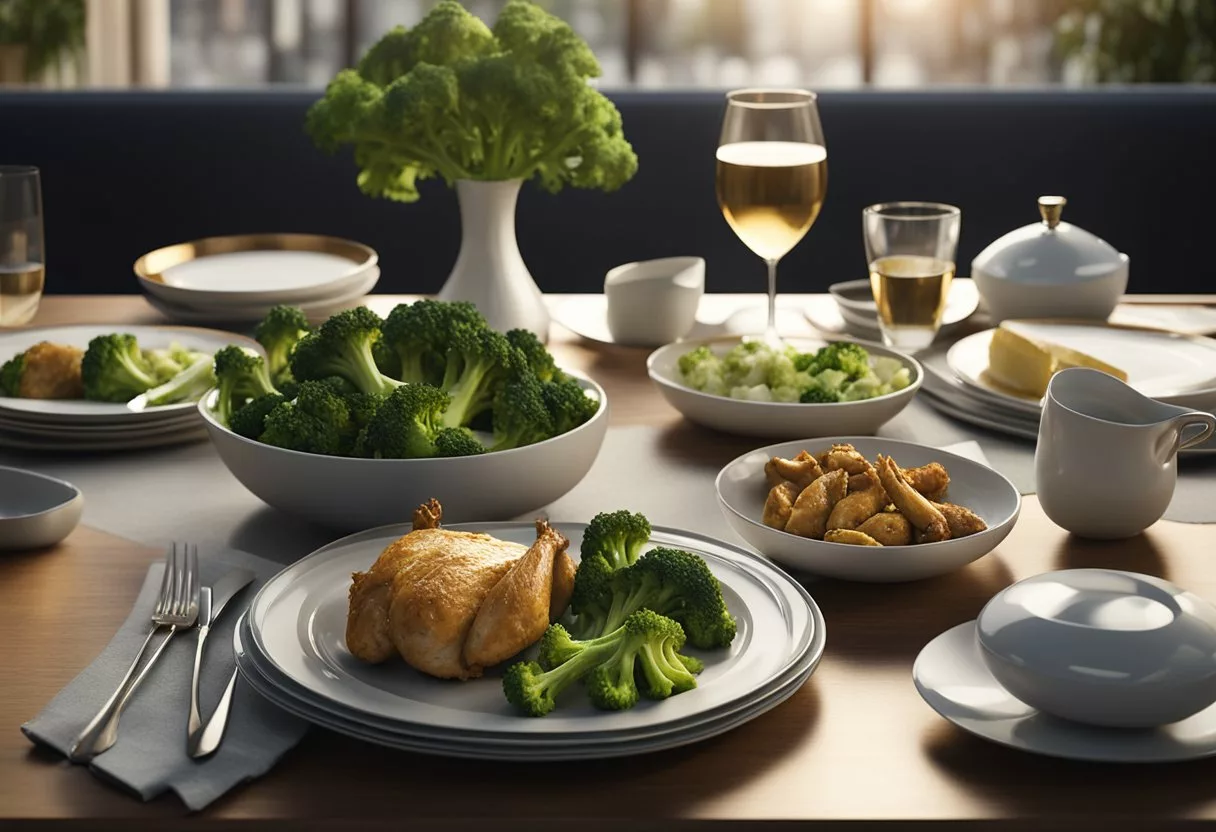
When adhering to the chicken and broccoli diet, individuals face unique challenges while dining out. One must pay close attention to meal composition and existing dietary restrictions to maintain the integrity of their diet.
Making Smart Choices
When dining out, making smart choices is critical for someone following the chicken and broccoli diet. They should look for dishes that closely align with their dietary requirements, such as:
- Grilled chicken: as it is often a leaner option with minimal added fats.
- Steamed broccoli: ensures no additional oils or seasonings that might be high in salt are included.
- Side salads: with dressings on the side, preferably olive oil and lemon juice instead of cream-based options to control fat and calorie intake.
To combat cravings, one may opt for herbal teas or water with a slice of lemon. It’s also wise to inquire if the chef can prepare a dish using minimal salt or substitute salt with spices and herbs to enhance flavor without increasing sodium intake.
Navigating Menus
Navigating menus requires a discerning eye. Individuals on this diet might:
- Ask if the kitchen can prepare a simple meal of chicken and broccoli if it’s not on the menu.
- Request that chicken be cooked without additional butter or oils. They can also suggest olive oil as a healthier alternative if necessary.
- Verify ingredients in dishes to exclude hidden sources of carbs and fats that might conflict with their dietary regimen.
- Opt for meals that are baked, grilled, or steamed. These cooking methods typically require less fat compared to frying or sautéing.
When it comes to dressings and sauces, it’s best to ask for them to be served on the side. This way, one can control the quantity used and ensure that it’s within dietary limits. This maintains a balance of flavor and nutrition while sticking to their chicken and broccoli diet.
Frequently Asked Questions
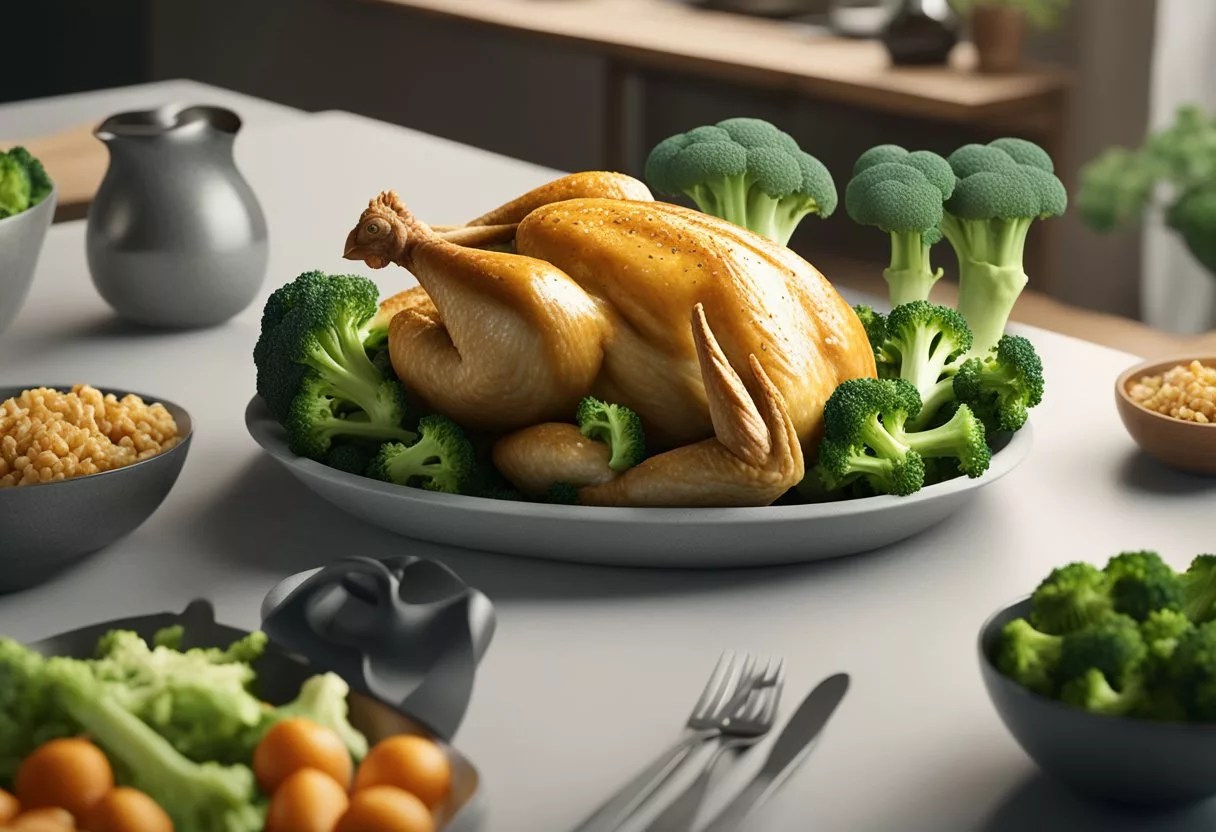
The Frequently Asked Questions section provides concise, accurate information to common inquiries regarding the chicken and broccoli diet. These responses aim to enhance understanding of the diet’s effects on health, weight loss, and nutrition.
What are the health benefits of following a chicken and broccoli diet?
A diet focused on chicken and broccoli offers a high protein intake. It is also rich in vitamins and minerals which can support muscle repair and bolster the immune system. Broccoli is particularly known for its fiber content and abundance of antioxidants.
How can I effectively plan a chicken and broccoli diet for weight loss?
Effective planning for a chicken and broccoli diet includes consideration of portion sizes. This helps maintain a low calorie intake while ensuring you receive adequate protein and essential nutrients. Incorporating portion control and meal timing can further support weight loss efforts.
Are there any risks associated with a long-term chicken and broccoli diet?
Following this diet long-term could lead to potential nutrient deficiencies. This is because it is restrictive and lacks variety. As such, it may fall short in supplying all the necessary dietary components like healthy fats and complex carbohydrates that are vital for a balanced diet.
What variety of recipes can I explore while on a chicken and broccoli diet?
There are numerous recipes that comply with the diet’s criteria. Some examples include stir-fries, steamed broccoli with grilled chicken, and broccoli and chicken casseroles. These can offer some variety within the permitted foods while still adhering to the diet’s principles.
How does the chicken and broccoli diet impact body transformation over time?
Over time, one may observe a reduction in body fat and some muscle definition due to the high protein, low carbohydrate nature of the diet, which can lead to weight loss. However, the degree of transformation varies depending on overall calorie intake and exercise habits.
What is the nutritional balance of a diet consisting mainly of chicken and broccoli?
This diet is significantly low in calories and high in protein. However, it may not provide sufficient carbohydrates, fats, and fiber for all individuals’ needs. It can be nutrient-dense, yet it lacks the dietary variety recommended for long-term health.